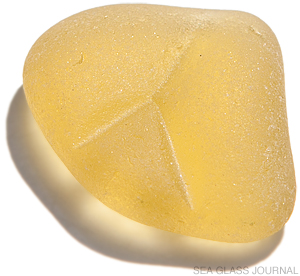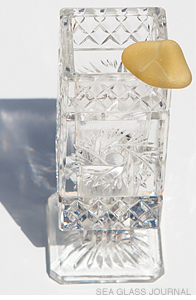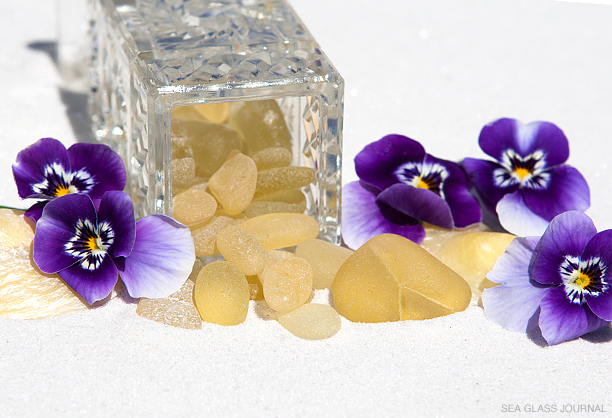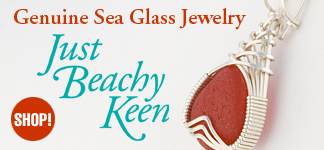The Sea Glass Shard of the Month: May 2015
A Yellow Pattern Glass Segment

See MORE IMAGES
Sea Glass Specifications:
Color: Soft Yellow Goldenrod
Max Length: 23.7 mm (0.94")
Max Width: 27.0 mm (1.06")
Max Thickness: 9.3 mm (0.37")
Weight: 5.9 grams (0.21 oz)
Estimated Age: 60 to 90 years old
This month we'll be taking a closer look at the history of pressed glass by featuring this soft yellow depression era sea glass specimen. Pressed glass developed back in the 1820s with the introduction of pressing machines that forced molten glass into patterned cast iron molds with the use of a plunger. The glassware produced from this process was marketed as a less expensive alternative to hand-cut crystal glassware.

Another example of press-molded pattern glass.
Facts of Interest
Painted pressed glass produced in the early 20th century is often called goofus glass.
Boston and Sandwich Works was one of the most famous of the pressed glass factories of the 19th century.
Early attempts at pressed glass produced glassware with lacelike effects and as such were termed Lacy Glass.
There were around sixteen factories in the 19th century that produced glassware using this technique, one of the most famous being the Boston and Sandwich Works located in Sandwich, Massachusetts. [1] Glassware of this type was made into everything from tableware, dinnerware, candlesticks, decorative ware and more in vibrant colors as well as clear leaded glass. The pressed glass made at this time is referred to as Early American Pattern Glass (EAPG) by collectors and is differentiated from the massed produced pressed glass made during the first half of the 20th century.
 |
Depression glass commonly came in softer, pastel shades... |
 |
In the late 1920s a new technology emerged allowing manufactures to produce appealing glassware with little or no handwork required in comparison to EAPG products. During the Depression this type of glassware was so cheap and widely available it become commonly known as Depression Glass. The featured sea glass specimen is from this era. Depression glass commonly came in softer, pastel shades in comparison to its earlier pattern counterparts and was widely produced late into the 1950s. This narrows the age of the featured piece to between 60 and 90 years old.
As mentioned in an earlier article referencing Depression Glass, a more refined type of glassware produced was called Elegant Glass. This glassware involved more hand and finish work and came in many more vibrant colors. While more expensive than Depression Glass it was still cheaper than the EAPG it was competing against.
Depression sea glass can be easily recognized because it usually came in pastel shades such as yellow, pink, blue and green and often has a geometric pattern associated with it. If your shard has a deeper cut pattern in a more vibrant color it may have come from an Elegant Glass product, or even more rare, an Early American Pattern Glass product. To increase your chances of finding such sea glass you should locate areas along the coast that were used as dumping grounds in the early part of the 20th century.
REFERENCES:
1. http://www.kovels.com/price-guide/glass-price-guide/pressed-glass.html

Keep up-to-date on all things sea glass... "Like Us" on Facebook... Sea Glass Journal on Facebook






